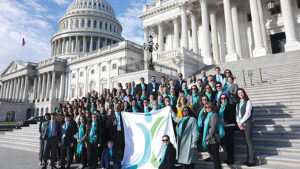According to the Tourette Association of America, Tourette syndrome (TS) is a neurodevelopmental disorder characterized by sudden, involuntary movements and/ or sounds called tics. They can include eye blinking, head jerking and facial movements such as throat clearing, sniffing and tongue clicking.
“The statistics on TS are that one in 100 school-age children have Tourette syndrome or tic disorders in some form,” according to Dr. Julie Savage Jones, a registered nurse with a doctorate in education who has served as the support group leader for the Tourette syndrome support group of central Alabama since 2013. She has three children with TS.
One out of every 100 children ages 5-17 has TS or another Tic disorder, according to the Tourette Association. It is now estimated that one million Americans are impacted, and 50 percent are going undiagnosed. Tourette syndrome affects all races, ethnicities, genders and ages, and it is three to four times more common in boys than girls.
“Tics can appear as early as three to four years but the average age is seven years, says Dr. Jan Rowe, OT, OTR/L, FAOTA, coordinator of the Tourette syndrome and Tic disorders Clinic and co-director, COA/UAB Tourette Center of Excellence at Children’s at Lakeshore.
“The worst years (peak) is 10-21 years of age,” Rowe explains. “One third of people’s tics resolve, one third lessen before adulthood and one third will have tics into adulthood.”
According to the Association, Tourette is underdiagnosed. Many children, parents, teachers and even physicians don’t fully understand TS, which can lead to bullying, a lack of community support, an improper diagnosis and a host of other issues that impair the quality of life for someone with TS. It is important to mention there is no cure for Tourette and the cause remains unknown, though it is thought to involve genetic, neurological and environmental factors that may be treated.
“TS can manifest in a number of ways, and it is multifaceted. It is not all about the tics,” Jones explains. “There are associated issues that go along with TS, such as Attention Deficit Hyperactivity Disorder, obsessive compulsive disorder, learning disabilities, anxiety and sensory issues.”
“The syndrome manifests in a number of ways,” Jones agrees. “My oldest son struggled in school. He had almost every one of the co-occurring conditions, including sensory issues. Certain sounds bothered him. The feeling of cotton used in art class bothered him. Many types of pencils (the way that they felt) bothered him. He could not sit still even in the fourth grade. He was impulsive. He made noises. All of these behaviors caused problems in school. As a result, I decided to homeschool him, starting in the fourth grade.”
Doctors look for the following to diagnose Tourette syndrome in particular, according to the Association:
• At least two motor tics and at least one vocal (phonic) tic have been present, not necessarily at the same time.
• Tics may wax and wane in frequency but have occurred for more than one year.
• Tics started to appear before the age of 18.
• Tics are not caused by the use of a substance or other medical condition. There is no cure for Tourette syndrome, but thanks to years of dedicated research, there are various treatment options.
Tourette syndrome is a lifelong condition, according to the Association. Some tic disorders may be transient, but for 66 percent of people, TS persists into adolescence and adulthood.
“Tics can cause physical discomfort, disrupt daily activities such as school work, social interactions, sleep and play,” Rowe says. “As children get older, work duties and even driving can be compromised because of tics.”
However, TS can be treated. “Individualized education plans can help children with TS and learning issues, Savage says. Comprehensive Behavioral Intervention for Tics is a therapy that has been found to be as effective as medications without the potential side effects of medication…. Sometimes homeschool is the best educational option. It has been for us, but it is not for everyone,” Jones says.
“The gold standard of care for children with tics and TS is Cognitive Behavioral Intervention for Tics (CBIT),” Rowe adds. “This is a non-pharmacological behavioral program. We teach strategies to interrupt tics. This is no cure for tic disorders but CBIT teaches youth to manage their ticks.”
Carol Muse Evans is the publisher and editor of Birmingham Parent.





